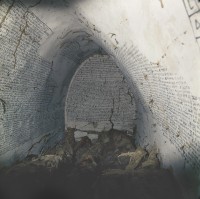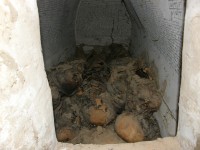The archaeological site of Old Dongola in what is today Sudan has a rich history. Originally built as a fortress in the fifth century, Dongola grew into a prosperous town thanks to its Nile-side location and, after its conversion to Christianity by the end of the sixth century, became the capital of the Coptic Christian kingdom of Makuria. In the seventh century, Makuria was able to defeat the forces of the Rashidun Caliphate after its successful invasion of Egypt. The ensuing peace treaty established trade relationships between Muslim Egypt and Christian Nubia that lasted for 600 years, a long period of stability that allowed the Kingdom of Makuria to flourish. The kingdom’s power began to wane in the 12th century and it was finally defeated by the Sultan of Egypt in the 14th century.
In 1993, the Polish Archaeological Mission (PAM) discovered three burial crypts in the northwest annex of a monastery in Old Dongola. Archaeologists believe they were part of a commemorative complex built either at the direction of or for the burial of Archbishop Georgios, Dongola’s primary cleric who was appointed directly by the Coptic Patriarch of Alexandria rather than via a national church hierarchy. According to a funerary stele found in the annex near the crypts, the archbishop died in 1113 A.D. when he was 82 years old.
 Inside each chamber were several natural mummies, some wrapped in textiles, and the walls of the southernmost crypt were covered with inscriptions written in Greek and Sahidic Coptic. The crypts were photographed and then resealed to preserve the contents until a more thorough excavation could be done. That finally happened in 2009.
Inside each chamber were several natural mummies, some wrapped in textiles, and the walls of the southernmost crypt were covered with inscriptions written in Greek and Sahidic Coptic. The crypts were photographed and then resealed to preserve the contents until a more thorough excavation could be done. That finally happened in 2009.
They found that the southern crypt (crypt 1) held seven mummies, one of which is thought to be the body of Archbishop Georgios. Archaeologists were not able to single out which of the bodies, if any, was the Archbishop’s. They are all adult males older than 40 and, judging from the extensive evidence of chronic and degenerative illnesses, probably older than that at the time of death. The bodies were dressed fairly modestly, mainly in linen garments, wrapped in shrouds and then interred in the crypt over a course of years. Four pectoral crosses were found in the crypt as well, two of them wood, one of them stone, one of them glass.
The inscriptions on the walls of crypt 1 provide a particularly fascinating glimpse into Makuria’s unique religious culture. Painted in black ink over a thin layer of whitewash, they cover the four walls of the barrel chamber almost entirely. They are in very good condition, except for areas where the walls themselves were damaged. The writing was all done by the same person, one Ioannes, who did us the favor of signing his name at the end of the inscriptions on the north, east and south walls. He probably signed the west wall too, but it was lost due to damage.
 Ioannes was better at Coptic than he was at Greek. There are copious errors in the Greek, some of which he covered with whitewash and redid, like Medieval white-out, which suggests he may have been trying to copy a text, which suggests he had access to a library, either in the monastery or perhaps the private library of the archbishop. It’s a reversal of what you might expect, since Greek was still going great guns in the Eastern Church while Sahidic Coptic was already a dying language by the end of the 11th century.
Ioannes was better at Coptic than he was at Greek. There are copious errors in the Greek, some of which he covered with whitewash and redid, like Medieval white-out, which suggests he may have been trying to copy a text, which suggests he had access to a library, either in the monastery or perhaps the private library of the archbishop. It’s a reversal of what you might expect, since Greek was still going great guns in the Eastern Church while Sahidic Coptic was already a dying language by the end of the 11th century.
The inscriptions begin on the west wall with an invocation of the Holy Trinity. Underneath that the writings are defined as a phylakterion malakias, a phylactery or amulet against weakness. A series of magical symbols in a frame follow, and beneath them are two lists, one of numerical cryptograms representing the names of god and angels, the other of magical divine names. Quotations from the gospels and prayers in Greek are next. One of the prayers, said to by the Virgin Mary, is well-known in a languages from Coptic to Arabic, but this is the first time it’s ever been found in Greek. Since Greek was probably its original language, it’s a highly significant find. The prayer ends abruptly with the invocation of a magical ritual meant to chase evil spirits from the tomb.
The inscription on the east wall quotes from the Gospel of Luke in Greek then moves on to a Coptic piece on the death of the Virgin Mary. It includes the prayer she spoke before she died and describes her final scene. This is an excerpt from a popular fourth century Coptic work by Saint Cyril of Jerusalem, but unlike every other extant version of the text known, the crypt inscription has a curious line: after Mary finishes praying, death appears to her “in the form of a rooster.”
From the paper on the inscriptions in the journal Polish Archaeology in the Mediterranean by University of Warsaw professor Adam Łajtar:
The decoration of the burial vault may therefore be properly described as a silent ritual, intended to safeguard not only the tomb, but primarily those who were buried inside of it during the dangerous liminal period between the moment of dying and their appearance before the throne of God. The entire ensemble of texts and architecture must be considered a unique and important witness to the funerary beliefs and practices of Christian northeastern Africa in medieval times.